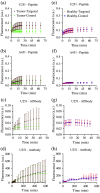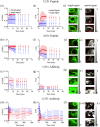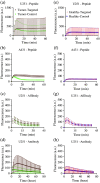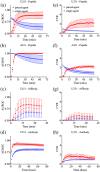Prediction of optimal contrast times post-imaging agent administration to inform personalized fluorescence-guided surgery
- PMID: 33200596
- PMCID: PMC7667427
- DOI: 10.1117/1.JBO.25.11.116005
Prediction of optimal contrast times post-imaging agent administration to inform personalized fluorescence-guided surgery
Abstract
Significance: Fluorescence guidance in cancer surgery (FGS) using molecular-targeted contrast agents is accelerating, yet the influence of individual patients' physiology on the optimal time to perform surgery post-agent-injection is not fully understood.
Aim: Develop a mathematical framework and analytical expressions to estimate patient-specific time-to-maximum contrast after imaging agent administration for single- and paired-agent (coadministration of targeted and control agents) protocols.
Approach: The framework was validated in mouse subcutaneous xenograft studies for three classes of imaging agents: peptide, antibody mimetic, and antibody. Analytical expressions estimating time-to-maximum-tumor-discrimination potential were evaluated over a range of parameters using the validated framework for human cancer parameters.
Results: Correlations were observed between simulations and matched experiments and metrics of tumor discrimination potential (p < 0.05). Based on human cancer physiology, times-to-maximum contrast for peptide and antibody mimetic agents were <200 min, >15 h for antibodies, on average. The analytical estimates of time-to-maximum tumor discrimination performance exhibited errors of <10 % on average, whereas patient-to-patient variance is expected to be greater than 100%.
Conclusion: We demonstrated that analytical estimates of time-to-maximum contrast in FGS carried out patient-to-patient can outperform the population average time-to-maximum contrast used currently in clinical trials. Such estimates can be made with preoperative DCE-MRI (or similar) and knowledge of the targeted agent's binding affinity.
Keywords: fluorescence-guided surgery; intraoperative visualization; kinetic modeling; optimal time of surgery; paired-agent imaging.
Figures







Similar articles
-
Synthesis and evaluation of a targeted nanoglobular dual-modal imaging agent for MR imaging and image-guided surgery of prostate cancer.Pharm Res. 2014 Jun;31(6):1469-76. doi: 10.1007/s11095-013-1008-5. Epub 2013 Mar 8. Pharm Res. 2014. PMID: 23471641 Free PMC article.
-
Improved Discrimination of Tumors with Low and Heterogeneous EGFR Expression in Fluorescence-Guided Surgery Through Paired-Agent Protocols.Mol Imaging Biol. 2023 Feb;25(1):110-121. doi: 10.1007/s11307-021-01656-3. Epub 2021 Oct 14. Mol Imaging Biol. 2023. PMID: 34651290 Free PMC article.
-
Paired Agent Fluorescence Imaging of Cancer in a Living Mouse Using Preassembled Squaraine Molecular Probes with Emission Wavelengths of 690 and 830 nm.Bioconjug Chem. 2020 Feb 19;31(2):214-223. doi: 10.1021/acs.bioconjchem.9b00750. Epub 2019 Dec 6. Bioconjug Chem. 2020. PMID: 31756298 Free PMC article.
-
Combination of Fluorescence-Guided Surgery With Photodynamic Therapy for the Treatment of Cancer.Mol Imaging. 2017 Jan-Dec;16:1536012117722911. doi: 10.1177/1536012117722911. Mol Imaging. 2017. PMID: 28849712 Free PMC article. Review.
-
Quicker, deeper and stronger imaging: A review of tumor-targeted, near-infrared fluorescent dyes for fluorescence guided surgery in the preclinical and clinical stages.Eur J Pharm Biopharm. 2020 Jul;152:123-143. doi: 10.1016/j.ejpb.2020.05.002. Epub 2020 May 8. Eur J Pharm Biopharm. 2020. PMID: 32437752 Review.
Cited by
-
Receptor-Targeted Fluorescence-Guided Surgery With Low Molecular Weight Agents.Front Oncol. 2021 Jun 30;11:674083. doi: 10.3389/fonc.2021.674083. eCollection 2021. Front Oncol. 2021. PMID: 34277418 Free PMC article. Review.
-
High-Contrast Detection of Somatostatin Receptor Subtype-2 for Fluorescence-Guided Surgery.Mol Pharm. 2022 Nov 7;19(11):4241-4253. doi: 10.1021/acs.molpharmaceut.2c00583. Epub 2022 Sep 29. Mol Pharm. 2022. PMID: 36174110 Free PMC article.
-
Quantifying Imaging Agent Binding and Dissociation in 3-D Cancer Spheroid Tissue Culture Using Paired-Agent Principles.Ann Biomed Eng. 2024 Jun;52(6):1625-1637. doi: 10.1007/s10439-024-03476-2. Epub 2024 Feb 26. Ann Biomed Eng. 2024. PMID: 38409434 Free PMC article.
-
Comparison of cRGDfK Peptide Probes with Appended Shielded Heptamethine Cyanine Dye (s775z) for Near Infrared Fluorescence Imaging of Cancer.ACS Omega. 2021 Oct 30;6(44):30130-30139. doi: 10.1021/acsomega.1c04991. eCollection 2021 Nov 9. ACS Omega. 2021. PMID: 34778684 Free PMC article.
-
3D-Printed Tumor Phantoms for Assessment of In Vivo Fluorescence Imaging Analysis Methods.Mol Imaging Biol. 2023 Feb;25(1):212-220. doi: 10.1007/s11307-022-01783-5. Epub 2022 Oct 28. Mol Imaging Biol. 2023. PMID: 36307633 Free PMC article.
References
Publication types
MeSH terms
Substances
Grants and funding
LinkOut - more resources
Full Text Sources
Medical

